Absorption By Roots Learning Objectives
After completing this chapter, you will be able to:
- Explain how roots are adapted for absorbing water;
- Describe the adaptation in roots for absorption of water and minerals;
- Explain diffusion, osmosis, imbibition, active transport, turgidity and plasmolysis and their importance for plants;
- Differentiate between diffusion, osmosis and active transport;
- Differentiate between turgidity and flaccidity, plasmolysis and Deplasmolysis;
- Explain the process of absorption of water and minerals by roots;
- Explain the ascent of sap in plants;
- Discuss the causative forces in the ascent of sap, namely cohesive, adhesive forces and transpiration pull.
Like animals, plants also need water and nutrients to survive. Plants absorb water and mineral nutrients from the soil through roots. The roots conduct these into the stem for supplying to upper parts like leaves, flowers, fruits, etc. How do water and minerals absorb from the soil move from one part to another part of the plant body? In this chapter, we will study about some fundamental processes that help in the absorption of water and minerals by the roots in plants.
Absorption By Roots Why Do Plants Need Water And Minerals?
Plants need water and minerals for many purposes as mentioned subsequently.
Need for water
- For photosynthesis: Water is used as a raw material for the synthesis of glucose during the process of photosynthesis.
- For transpiration: It is used for cooling the tree in warm weather and for generating a pull/suction force for the movement of sap by transpiration.
- For transportation: It helps in the upward transport of minerals from the roots into the shoot system and for the transport of food manufactured in leaves to other parts.
- For mechanical strength: It is required for providing turgidity, which makes plant tissues stiff and gives them strength.
| Class 10 Science | Class 11 Chemistry |
| Class 11 Chemistry | Transformation of Sentences |
| Class 8 Maths | Class 8 Science |
Need for mineral nutrients
- For movement of substances through the cell membrane (calcium)
- For respiration (iron) and cell division (phosphorus)
- For activating the enzymes (potassium, magnesium)
- For making chlorophyll (magnesium)
- For being part of nucleic acids, chlorophyll, proteins (nitrogen)
- For serving as building blocks of many compounds synthesized by plants such as a new protoplasm, etc.
Absorption By Roots How Are Roots Adapted For Absorption Of Water?
- Roots contain root hair that provide large surface area: A plant may contain millions of root hair, which together provide large surface area for the absorption of water.
- The epidermis of root hair is permeable to water: The root hair has very thin walls that are freely permeable to water. The thin walls help in easy movement of water and minerals in and out of cells.

- Most of the absorption of water and minerals occurs near root tips. The soil particles, which are usually coated with water and dissolved minerals, adhere tightly to the root hair. The soil solution flows in and out of the root hair cells.
- Root hair contains cell sap, which is at a higher concentration of minerals than the surrounding water: Root hair grows from the outer layer of the cortex. Between the cells of the cortex are large air spaces (vacuoles) that allow diffusion of gases and movement of water. The spaces allow water to get into the root by capillary action. The large vacuoles in the plant cells contain a solution called cell sap, which contains dissolved salts and is therefore of a higher concentration than the surrounding water. This facilitates osmosis, as a result of which water from outside is drawn inside the root hair.
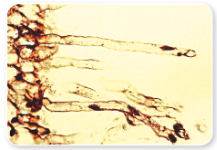
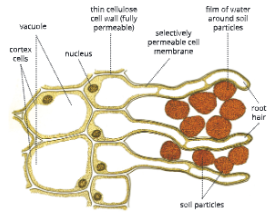
How Do Absorption And Conduction Of Water And Minerals Occur?
The absorption of water and minerals from the soil by the root hair, their movement through the thickness of the root and then upward conduction through the stem to the leaves of the plant takes place through the following processes.
- Diffusion
- Osmosis
- Imbibition
- Active transport
- Turgidity and flaccidity
Diffusion
The movement of molecules of a substance from a region of their higher concentration to a region of their lower concentration is called diffusion.
Large molecules move much more strongly than small molecules. If you add a small drop of dye (like ink) to one end of a tub of water without disturbing it, the dye starts dissolving. It would take a long time for the ink molecules to diffuse throughout the tub and reach a state of equilibrium.
 A-barrier-separates-two-kinds-of-molecules
A-barrier-separates-two-kinds-of-molecules

When the barrier is removed, random movement of molecules results in both kinds of molecules moving from a region of higher concentration to a region of lower concentration.

Eventually, an equilibrium (even distribution) is reached. The diffusion gradually slows down as equilibrium is approached.
Absorption by Roots Activity 1
To study the diffusion of a soluble dye in water. Take a beaker containing water. Put a small crystal of potassium permanganate in one corner of the beaker. Observe for some time. You will observe that the potassium permanganate crystal slowly starts dissolving. After some time, the molecules of the dye distribute uniformly throughout the water.
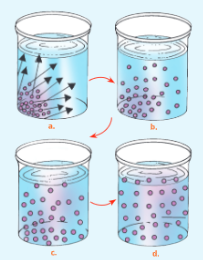
- The molecules of dye are more concentrated in crystal form. When added to water they begin to dissolve.
- The molecules move away from the region where they were added (region of higher concentration) to a region where they are less in number (region of lower concentration).
- Finally, the molecules of dye have been uniformly distributed (state of equilibrium).
Importance of diffusion
- Diffusion of water keeps the wall of the internal plant tissue moist.
- It helps in the distribution of ions and molecules throughout the protoplast.
- Loss of water vapour from the stomata during transpiration is through diffusion.
- Aroma (smell) of flowers is due to diffusion of aromatic compounds from flowers to attract pollinators.
Osmosis
- The movement of water molecules from a region of their higher concentration (more dilute solution) to their lower concentration (less diluted solution) through a semi-permeable membrane is called osmosis.
- In other words, osmosis is the movement of only water from its pure state or solvent from a dilute solution into a stronger or concentrated solution through a semi-permeable membrane.
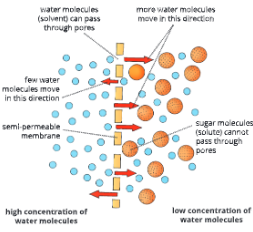
Endosmosis and Exosmosis
- The inward movement of water molecules through a semi-permeable membrane when the surrounding solution is less concentrated is called endosmosis (endo: inward). Endosmosis leads to swelling up of cells.
- The outward movement of water molecules through a semi-permeable membrane when the surrounding solution is more concentrated is called exosmosis (Exo: out.vard). Exosmosis leads to the shrinking of the cells.
Absorption By Roots Activity- 2
To demonstrate osmosis through a thistle funnel.
- Take a thistle funnel and fill it with concentrated sugar solution. Cover the mouth of the thistle funnel with cellophane paper. Tie the cellophane paper as shown in the Figure.
- Now take a beaker filled with water. Invert the thistle funnel in the beaker and suspend it with a stand as shown in Figure 4.7. Mark the level of sugar solution on the stem end of funnel and level of water in the beaker. Leave the set-up for about two hours.
- Set the same experiment but without taking sugar solution in the thistle funnel. Instead, take water in the thistle funnel and mark the reading. This serves as a control set-up.
- After about two hours you will observe that the level of sugar solution in the thistle rises only in the experimental set-up and not in the control.
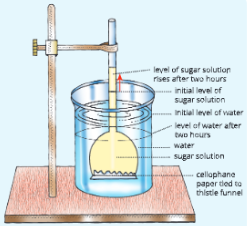
- The level of water in the beaker in the experimental set-up drops slightly while it remained unchanged in the control.
Conclusion
This shows that:
- the water molecules are able to move from a dilute solution (water in a beaker) into the concentrated sugar solution (in the thistle funnel) through the cellophane paper.
- Sugar solution from the funnel did not pass into the beaker.
- Cellophane paper acts as a semi-permeable membrane. Only water molecules could pass through it.
What will happen if you use a rubber sheet instead of cellophane as a barrier?
There will be no change in the level of sugar solution as the rubber sheet is an impermeable membrane and would not allow the water molecules from the beaker to cross over to the other side.
What will happen if you use muslin cloth instead of cellophane as a barrier?
Since the pores in the muslin cloth are very large, they will not hold back even the sugar molecules and all the sugar solution will flow out to a common level due to gravity.
Absorption By Roots Activity-3
To demonstrate osmosis through a Viking bag.
Repeat the earlier mentioned activity (no. 2) by using a Viking bag. The Viking bag acts as a semi-permeable membrane.
- Take a Viking bag and tie a knot at one end. Fill this bag with sugar solution from the other end. Insert a long glass capillary tube into it. You will find that the sugar solution rises in the capillary.
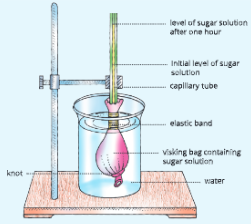
- Now immerse the visking bag in a beaker containing water and clamp the capillary tube vertically. Leave the experimental set-up for about one hour.
- After about 1 hour you will find that the level of sugar solution in the capillary tube rises. This happens because the water from the beaker diffuses inside through the walls of the visking bag into the more concentrated sugar solution.
Osmotic pressure
- The results of the above activities show that the pressure builds up in the sugar solution and forces the solution up the capillary tube. The pressure results from the rapid diffusion of water molecules from the dilute to the more concentrated solution.
- The osmotic pressure is the minimum pressure that needs to be applied to a solution to prevent the inward flow of pure solvent (water) into the solution when separated by a semi-permeable membrane.
- Osmotic pressure can also be defined as the pressure required to completely stop the entry of water into a solution across a semi-permeable membrane. It can also be defined as the measure of the tendency of a solution to take in water by osmosis.
Osmotic potential
- The osmotic potential of a solution is a measure of the tendency of water molecules to diffuse out of it. A concentrated solution that has relatively few water molecules has a low osmotic potential. On the other hand, a dilute solution with a larger proportion of water molecules has a high osmotic potential.
- Pure water has the highest possible osmotic potential.
- Movement of water in a plant occurs from a dilute solution of a high osmotic potential to a concentrated solution of a low osmotic potential.
Importance of osmosis
- Water absorbed by roots moves to the upper parts of a plant from cell to cell through osmosis.
- Osmosis plays a key role in the growth of radicles and plumules during seed germination.
- Cell-to-cell movement of water occurs through osmosis.
- Living cells remain turgid or distended due to osmosis.
- The stomata are open and close in response to increase or decrease in osmotic pressure of the guard cell.
- The differences between diffusion and osmosis are given in the Table.

Tonicity: Isotonic, Hypotonic And Hypertonic Solutions
- The relative concentration of a solution which determines the direction and extent of diffusion is called tonicity. Based on tonicity, solutions can be classified into three types – isotonic, hypotonic and hypertonic.
- If you take a plant cell and place it in solutions that are of different concentrations you will find that the cell shrinks in a hypertonic solution, swells in a hypotonic solution and remains unchanged in an isotonic solution.
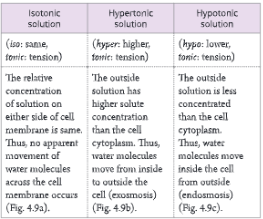
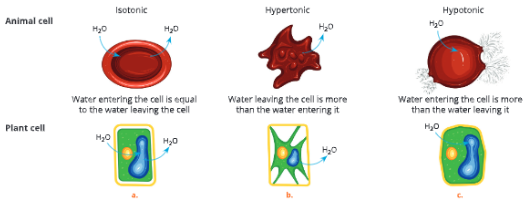
Imbibition
- Osmosis is not the only force involved in the absorption of water by plants. Substances such as cellulose and starch are hydrophilic, i.e. they have a strong affinity for water. They can absorb water and swell up.
- Imbibition is the process by which plant cells (living or dead) absorb water by surface attraction. Imbibition results in swelling of tissues and rupturing of seed coat for germination of seeds. Swelling of wooden doors during rainy season is also due to imbibition.
Passive transport
- Diffusion, osmosis and imbibition are examples of passive transport in plants. Passive transport always takes place along the concentration gradient and requires no energy from the cell.
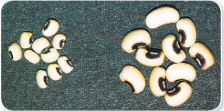
Active Transport
The passage of salt or ions of a substance from its lower concentration to a higher concentration utilizing the energy from the cell through a living membrane is known as active transport.
Active transport is just opposite to diffusion. The ions of certain elements such as nitrates, sulphates, manganese, etc., cannot easily pass through the cell membranes of root cells. This is because their concentration is higher inside the root cells than in the surrounding soil water.
Thus, the ions of such elements move inside root cells (the region. of their higher concentration) from outside (the region of their lower concentration) using the energy (ATP). The differences between diffusion and active transport are given in Table.

Turgidity And Flaccidity
Turgidity
The root hair of plants are permeable to water. The cell sap inside the vacuole contains salts and sugars and is highly concentrated. If this cell is surrounded by water, osmosis will cause water to enter the cell sap.
As a result, the vacuole would expand, pushing the cell cytoplasm against the cell wall. Eventually, a condition will arise when no more water can enter the cell. Such a cell cannot accommodate any more water and is called turgid and the condition is called turgidity.
Turgor pressure
The pressure of the cell contents against the cell wall due to movement of water into the cell during osmosis is called turgor pressure. The pressure exerted by the cell wall on the cell contents is called wall pressure.
Turgor pressure and wall pressure counterbalance each other. As a result, even if the concentration of solute inside the cell is greater than that outside of a cell, further absorption of water does not take place.
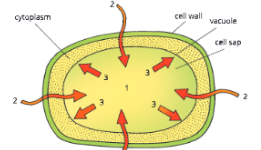
1. Salts and sugars in cell sap make it concentrate inside
2. water enters the cell by osmosis
3. The cell sap volume increases, pushing the cell wall outward making it turgid.
Uses Of Turgor Pressure
- Turgor pressure keeps the cells and their organelles stretched, which is essential for the proper functioning of a cell.
- It is necessary for the enlargement of cells.
- It provides support to living tissues like parenchyma.
- It keeps the leaves fully expanded and oriented towards the light. In case of loss of turgidity, the shoots droop down and leave wilt. Rapid drooping of the leaves of the sensitive plant, Mimosa pudica in response to touch is due to turgor movement.
- Flowers, soft stems and other soft parts of a plant are able to maintain their shape due to turgidity or turgor pressure.
- It keeps a check on the excessive entry of water into the cells.
- A plant cell may burst when turgor pressure exceeds wall pressure.
Turgor pressure in root cells builds up root pressure
Root pressure is the pressure developed in the roots due to the continued inflow of water by cell to cell osmosis. This helps in ascent of sap upwards through the stem. If you cut off the shoot of a plant, the water
Absorption By Roots Activity- 4
To study turgor pressure in root cells-Root pressure
- Take a well-watered, potted plant such as balsam and cut it a few centimetres above the soil level.
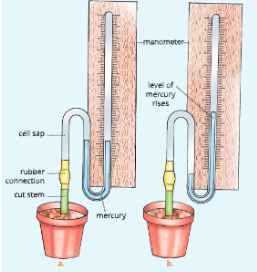
- Immediately fix a glass tubing over the cut portion with the help of a rubber connection. The other end of this tubing is connected to a manometer.
- You will observe that water starts coming out of the cut end of the plant and exerts pressure and raises the level of mercury in the connected manometer. This upward movement of water is due to the heavy root pressure.
- immediately comes out from the cut portion. This is due to root pressure. To understand it better let us perform an activity (activity 4).
Turgor pressure helps in the opening and closing of stomata
- During photosynthesis, glucose is synthesized from CO₂ and H₂O. This causes an increase in the osmotic pressure of the contents of guard cells.
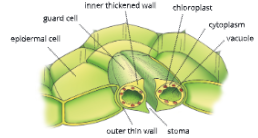
- As a result, guard cells absorb more water from the neighbouring cells, thus becoming turgid. The high turgor pressure causes the guard cells to bulge out and the stoma opens. At night, since no photosynthesis takes place, there is a shortage of water in the leaf and the guard cells become flaccid, their inner walls become straight and the stomata are closed.
Turgor movement
- In the sensitive plant, Mimosa pudica, the stimulus of touch leads to the loss of turgor pressure at the base of leaflets and the leaves droop down (fold) within 2-3 seconds of touching. This is an example of the turgor movement.
- The bending of certain flowers (e.g. sunflower) towards sun is due to the turgor movement.
Flaccidity
Flaccidity reverse of turgidity. If a fully-distended (turgid) cell is placed in a hypertonic solution, the water moves out of the cell due to exosmosis and the cell loses turgidity. The cell is called flaccid and the phenomenon is known as flaccidity. Cells remain flaccid when placed in isotonic solution.
A condition in which the cell contents shrink and the cell loses its turgidity is called flaccidity.
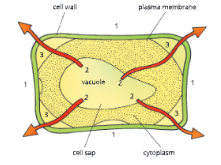
1. Solution outside is more concentrated than the cell sap.
2. Water passes out of the vacuole by osmosis.
3. The vacuole shrinks, pulling the cytoplasm away from the cell wall and leaving the cell flaccid
Plasmolysis And Deplasmolysis
Plasmolysis
- Shrinkage or contraction of the cytoplasm (cell content) of a cell from its cell wall when placed in a hypertonic solution is called plasmolysis.
- If we place a living turgid cell in a hypertonic solution, outward movement of water (exosmosis) occurs from the central region of the cell. As a result, the size of the cytoplasm reduces, and the plasma membrane is withdrawn from the cell wall. This is called plasmolysis and the cell is called a plasmolysed cell.
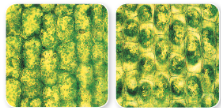
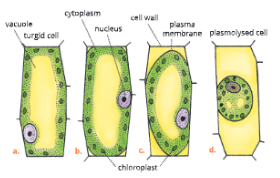
A cell in normal turgid condition;
Successive stages in shrinkage of cytoplasm from the cell wall after being placed in a hypertonic solution
Deplasmolysis
- If a plasmolysed cell is placed in water, its shrunk cytoplasm swells up and presses against the cell wall.

- This happens due to endosmosis. The swelling up of a plasmolysed cell under the influence
of hypotonic solution or water is called deplasmolysis. Deplasmolysis is possible only if the cell is alive and its cytoplasm is not dead or damaged. Differences between plasmolysis and deplasmolysis are given in Table.
Absorption Of Water And Minerals By The Root
Absorption of water
The absorption of water occurs through root hair. Root hair are thin-walled extensions from the cells. of the outer layer of a root. They grow out pushing between the soil particles. There is a film of water that surrounds the soil particles and in turn root hair also.
- The root hair contains cell sap which has a higher concentration of salts than the outside soil water. This causes osmosis and the water from outside diffuses into the cells of root hair (let us take it as cell A). This is due to root pressure.
- As water enters the vacuole of cell A, it dilutes the concentration of sugar and salts in its cell sap.
- Another cell (assume cell B) next to cell A has a higher concentration of cell sap (salts and sugars). As a result water from cell A moves to cell B.
- The water entering cell B makes its cell sap dilute and then moves to cell C. This way water moves from one cell to another by cell-to-cell osmosis.
- The water ultimately passes into the xylem vessels at the centre of root and is conducted up the root and stem into the leaves.
- The water and minerals absorbed by the roots are transported through xylem tissue through the ascent of sap.
Absorption of minerals
Absorption of mineral elements by the root from the soil takes place by active transport. The water film around the soil particles also contains a low concentration of mineral elements. These mineral elements move from soil into the root cells against the concentration gradient. Energy in the form of ATP is required by the cell for the absorption of minerals.
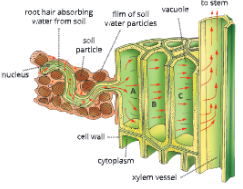
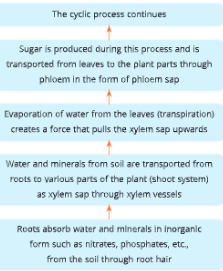
Ascent Of Sap
The upward movement of water and mineral salts from roots to the aerial parts (leaves, flowers, branches, etc.) of the plant, against the gravitational force, is called ascent of sap.
The elongated, lignified tracheids and xylem vessels, are placed end-to-end without any cross wall. They form the pipeline for conducting water and minerals from the roots to the leaves.
Water enters the root hair cells by imbibition and then by the process of osmosis. This water from the root hair cells passes into the xylem vessels through the cells of the cortex, endodermis and pericycle.
Ascent of sap takes place from the root, into the stem and finally the leaf veins through the xylem vessels and tracheids by means of a pull exerted by the leaf cells at the top of the sap column.
The cohesive force between the water molecules also helps to maintain the continuity of the water column.
The cohesive force is the force adhesion which keeps molecules of the same substance together, for example, water molecules.

a. Transverse section through a dicot root showing absorption of water by root hair
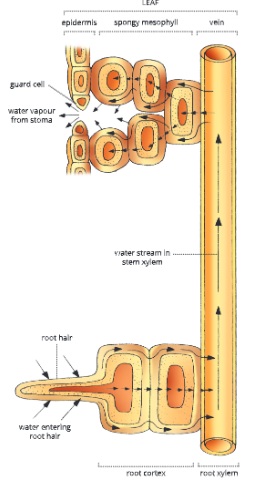
Pathway of water through the plant
Absorption By Roots Activity 5
To show that xylem is the path of ascent of sap.
- Cut two leaf shoots of the balsam plant underwater. Keep their lower ends dipped in water. In one shoot remove 2-4 cm long ring of bark (phloem) roughly from the middle region of the shoot.
- Remove the xylem from the central part of the second shoot (Fig. 4.19b). Fix the shoots with the bola of the help of a stand and leave the apparatus as such for 1-2 days.
- Result: In the first case (Set-up a), the leaves remain turgid even after 24 hours which shows that water continues to rise even if the phloem is removed. Leaves of the second shoot (Set-up b) get wilted. This shows that when xylem is removed, water cannot rise up.
The experiment proves that water rises through the xylem vessels.
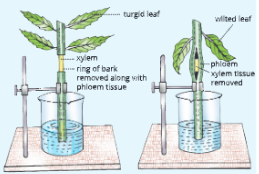
In the leaf blade, water passes from the xylem into the cells of the mesophyll and epidermis by the process of cell-to-cell osmosis.
Causative Forces For Ascent Of Sap
- As the water moves upward from roots to the leaves, a lot of it evaporates through the stomata present on the leaf epidermis. This process of evaporation of water from leaves and other aerial parts of the plant is called transpiration.
- The xylem sap (water containing minerals) rises against the gravity without the help of any mechanical pump. The xylem sap is largely pulled upward by transpiration – cohesion-tension mechanism, also called transpiration pull.
- Root pressure (pushing xylem sap): Root pressure is a pressure created due to the continuous influx of water in the xylem vessels from the root hair and root cortex. Root pressure causes guttation, the exudation of water droplets that can be seen on leaf surface. In most plants, root pressure is not the major mechanism during the ascent of sap. At the most, root pressure pushes the sap in the xylem vessels up to a certain height. Later on, the sap moves with cohesion, adhesion and transpiration pull.
- Capillarity nature of xylem vessels: Xylem vessels are very narrow. This causes the water from a lower level to rise by capillary action in order to fill up the vacuum created at the leaves due to the loss of water by transpiration.
- Pulling xylem sap: Transpiration – Cohesion- tension mechanism or transpiration pull: Stomata are the sites of exchange of CO₂ and O₂ between photosynthetic tissues and atmosphere. They are also the sites for transpiration. The air in these stomata is saturated with water vapour since it is in contact with most walls of the mesophyll cells (Fig. 4.20). On most of the days, the air is drier outside the leaf, i.e. it has a lower water concentration outside than inside the leaf. Thus, the gaseous water diffuses outside the leaf through the stomata and there is a loss of water during transpiration.
- This leads to a generation of tension (negative pressure) in the leaf due to the unique physical property of water. The thin film of water vapour present in the mesophyll cells replaces the water vapour which is lost from the leaf stomata by transpiration.
- During this process, water is pulled on by the adhesive and cohesive forces between the molecules of two different substances.
- This tension is the pulling force or suction force which draws water from the leaf xylem through the mesophyll cells toward stomata. The water lost via transpiration is replaced by the water that is pulled out of the leaf xylem.
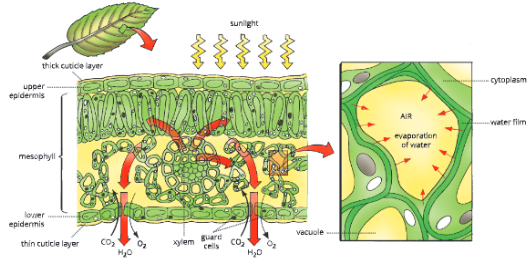
- Cohesion and adhesion of water: The transpiration pull on water extends from the leaves up to the root tip and even into the soil solution.
- This cohesion of water is due to hydrogen bonding between water molecules. Each water molecule is attached (adhered) to an adjacent water molecule and this pull is relayed from molecule to molecule down the entire column of water in the xylem.
Absorption By Roots Activity 6
To show that water is conducted through xylem tissues.
- Take a young, medium-sized balsam plant. Remove this plant from soil, wash it and place it in a beaker. Half fill this beaker with water containing eosin stain solution (pink colour).
- Ensure that the roots are completely submerged in the solution. Leave this set-up for about 3-4 hours. Now remove this plant from beaker and wash it in running tap water.
- Cut transverse section passing through roots, stem and leaves with the help of a sharp razor or a blade. Mount the sections on the slides and observe under a microscope.
- You will observe that in the centre xylem vessels appear red due to conduction of eosin stain dye. This shows that water is conducted through xylem tissue.
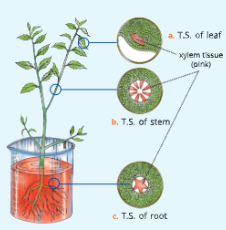
Absorption By Roots Summary
- Plants need water and minerals for many purposes such as growth, photosynthesis, transpiration, mechanical strength and transportation of nutrients.
- Roots bear root hair that provides enormous surface area. The epidermis of root hair is permeable to water.
- The movement of molecules or ions of a substance from a region of their higher concentration to a region of their lower concentration is called diffusion. Diffusion of water molecules keeps the cell wall of the internal plant tissues moist and helps in the transpiration of water vapour from stomata.
- Osmosis is the movement of water from its pure state or diluted solution into a concentrated solution through a semi-permeable membrane. The inward movement of water is called endosmosis and outward movement of water is called exosmosis.
- The osmotic pressure is the maximum pressure which can develop in an osmotically active solution when it
Is separated by a semi-permeable membrane to stop further endosmosis of water from a region of low concentration to the region of higher concentration of solute. - Imbibition is the process by which plant cells absorb water by surface attraction.
- The passage of salt or lons of a substance from their lower concentration to higher concentration through a living cell membrane using the energy from the cell is called active transport. The loss of elements moves into roots through active transport.
- The condition, when a cell reaches a state where it cannot accommodate any more water is called turgidity.
- The pressure of the cell contents against the cell wall is called turgor pressure. Flaccidity is reverse of turgidity.
- Shrinkage of cytoplasm of a cell from its cell wall under the influence of a hypertonic solution is called plasmolysis. The condition opposite to it is deplasmolysis.
- Absorption of water occurs through root hair by the process of osmosis. Minerals move from soil into root hair through active transport.
- The water and mineral salts enter the root by moving between the cells before entering xylem. Water also enters root hair; then passes through the cells of the cortex and endodermis to reach xylem vessels.
- The water and minerals absorbed by roots are conducted up through the xylem tissue.
- The upward movement of water and minerals from the roots to the aerial parts of plants against the gravitational force is called ascent of sap.
- Xylem sap is pulled upward by root pressure, capillary action of xylem vessels, transpiration-cohesion-tension mechanisms, and cohesion and adhesion of water.
